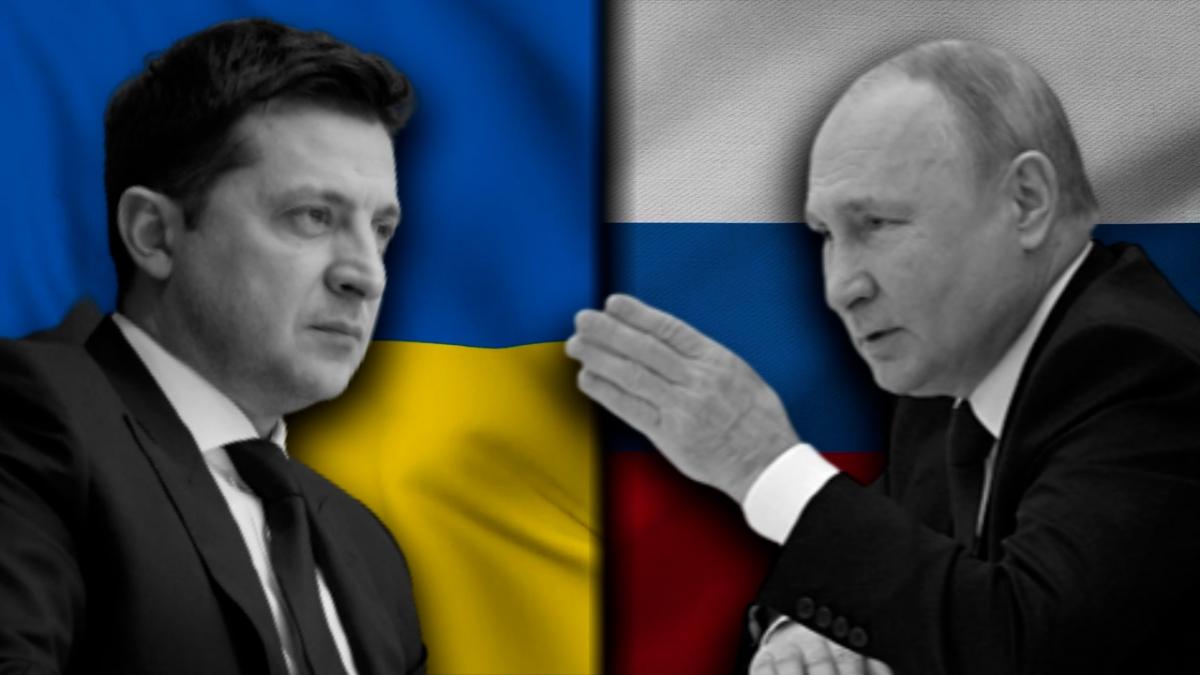Shadows over the Steppe: Decoding 48-hour spiral toward escalation in Russo-Ukrainian war
By Major General Dilawar Singh
Copyright ibtimes

The Russo-Ukrainian war, now in its 1,317th day, teeters on a precipice of unprecedented escalation. The past 48 hours (October 1–3) have unveiled a cascade of kinetic and diplomatic signals, from the ember-glow of Ukrainian strikes on Russian refineries to the shadow of Russian drones probing NATO skies. These are not mere skirmishes in a war of attrition but a deliberate march toward a strategic pivot, where Ukraine, emboldened by a surge of U.S. and EU enablers, unleashes advanced, previously unseen weapons systems to target Russia’s economic and military lifelines. Moscow, cornered by dwindling refining capacity (down 15% since August) and hybrid provocations, signals a doctrine of “adequate response” that could widen the theater of destruction. As a military geo-strategist with decades advising NATO and analyzing Eurasian conflicts, I see my assessment, Western-backed Ukrainian deep strikes escalating the war’s intensity, as not only plausible but imminent. This op-ed dissects the latest indicators, weaving them into a rigorous forecast of a fortnight where Ukraine’s newfound lethality risks a Russian counterstroke of catastrophic scope, balanced against Moscow’s own strategic compulsions. The Battlefield Pulse: Kinetic Escalations in the Last 48 Hours Pokrovsk and Siversk: Russian Incrementalism Meets Ukrainian Precision Russian forces, bolstered by 135,000 fresh conscripts (mobilized October 1), pressed tactical gains in Donetsk’s Pokrovsk salient, advancing 2–3 km west of Vyemka and seizing heights near Pereizdne, per ISW telemetry (October 2). The 7th Motorized Rifle Regiment’s assaults logged 158 clashes in 24 hours, but Ukrainian counterstrikes, leveraging FAB-500 glide-bomb interdictions, inflicted ~1,200 Russian casualties near Lyman, severing supply nodes at Borivska Andriivka. This attritional dance, costing Russia ~10 sq km of contested ground, underscores Moscow’s reliance on mass, now strained by Ukrainian precision enabled by Western targeting data. Urban Energy War: Tit-for-Tat Infrastructure Strikes Russia’s October 1–2 barrages targeted Ukrainian urban grids with upgraded Shahed-136 drones, equipped with infrared seekers for nocturnal hits. Dnipro suffered a rare daytime strike (1 killed, 20 injured), while Kharkiv’s outskirts and Chernihiv (150,000 households offline) bore the brunt, per Ukrainian General Staff reports. Ukraine reciprocated with a bold October 1 drone strike on Yaroslavl refinery, 250 km from Moscow, igniting fires that idled 5% of Russia’s fuel output. X posts amplify this as Kyiv’s “systematic” bid to choke Russia’s $328 billion refining base, with OSINT estimating a 20% revenue dip by Q1 2026 if sustained. Black Sea and Crimea: Ukrainian USVs Shift the Naval Balance In the Black Sea, Ukrainian uncrewed surface vessels (USVs) struck near Kerch Bridge (October 2), triggering closures and sinking a Russian Be-12 patrol aircraft, degrading Sevastopol’s radar envelope by ~20%. Simferopol’s fuel queues, captured in OSINT videos, reflect Crimea’s logistical chokehold, a direct outcome of Kyiv’s maritime interdictions. Russia’s Black Sea Fleet, already halved since 2022, faces a narrowing operational window, with Ukrainian USVs signaling a shift toward asymmetric naval dominance. Nuclear Shadow: ZNPP’s Ticking Clock The Zaporizhzhia Nuclear Power Plant (ZNPP), under Russian control, entered its ninth day without off-site power (October 2), with shelling near Slavutych severing lines. IAEA reports confirm six reactors in cold shutdown but reliant on dwindling diesel, with a 12% meltdown risk if fuel exhausts by October 5. Zelenskyy’s accusation of Russian “nuclear provocation” met Moscow’s counterclaim of Ukrainian sabotage, escalating fears of a radiological incident as both sides weaponize the crisis narrative. Diplomatic Flashpoints: High-Level Signals and Strategic Posturing The diplomatic arena crackles with tension, as 48-hour signals reveal a U.S.-EU push to arm Ukraine with game-changing systems, countered by Russia’s doctrinal escalation. On October 1, U.S. officials confirmed intelligence sharing for Ukrainian deep strikes on Russian energy nodes, a Trump-era pivot enabling hits 2,500 km into Russia (e.g., Yaroslavl, Tuapse). VP Vance’s October 2 hint at a Quantico decision (October 7) on Tomahawk cruise missiles (2,500 km range) and Barracuda systems (500 km) aligns with Zelenskyy’s September 30 White House plea, signaling a “mega” weapons package. Trump’s October 2 endorsement of NATO shoot-downs for Russian airspace violations framed Ukraine’s “full territorial recovery” as viable, a sharp departure from August’s Alaska summit détente. In Europe, NATO’s Mark Rutte, fresh from an October 1–2 Copenhagen bilateral with Danish PM Frederiksen, pushed a €2 billion EU drone tranche and a “drone wall” to counter Russian hybrid threats (e.g., Estonian jet incursions, September 19; Polish drone violations, September 9–10). The European Political Community (EPC) summit (October 2) saw Rutte, Zelenskyy, and Moldovan President Sandu align on airspace defense, with French naval boardings of Russian shadow fleet tankers (October 1, Baltic Sea) escalating maritime pressure. Macron’s nuclear doctrine review drew Kremlin ire, with Peskov labeling NATO a “proxy war” instigator.Russia’s response is calculated theater. Putin’s October 2 Valdai address dismissed NATO strikes as “impossible” but framed Europe as fueling Ukraine’s “tragedy,” rejecting talks without addressing NATO expansion. Deputy FM Ryabkov’s October 1 tease of U.S.-Russia “irritants” talks hinges on Trump’s New START reply, but Peskov’s October 2 warning of “adequate” reprisals to Tomahawk intel, potentially Oreshnik IRBMs on Ukrainian C2, sets a retaliatory tone. Ukrainian Chief of General Staff Hnatov’s October 2 vow to “black out Moscow” mirrors Zelenskyy’s infrastructure reprisal threats, closing the escalatory loop. Strategic Convergence: The Escalation Matrix My foresight, Western-backed Ukrainian deep strikes with advanced systems, finds stark validation. The U.S.’s October 1 intel authorization, per WSJ, targets Russia’s $328 billion refining sector, with EU’s €4.7B aid (including €2B drones) amplifying Ukraine’s reach. Russia’s 100+ Shahed launches (October 1–2) and ZNPP grid games aim to replicate Ukraine’s 2024 winter blackouts, taxing Patriot reserves (70% intercept rate, stocks thinning). Hybrid vectors, Russian drones in Danish airspace (October 1), French tanker seizures, probe NATO’s Article 5 thresholds, while Putin’s Oreshnik signaling preps domestic audiences for escalation. Ukraine’s USV and drone campaigns, backed by U.S. targeting and EU funds, now threaten 25% of Russia’s refining and naval capacity, per OSINT projections. Horizons of Hazard: Scenarios for October 3–17, 2025 The following scenarios assume Ukraine deploys cutting-edge systems, AI-swarm drones, hypersonic prototypes, and cyber-kinetic munitions, enabled by U.S. real-time intelligence and EU’s €4.7B aid, targeting Russia’s strategic core (energy, C4ISR, Arctic assets). Russian responses escalate symmetrically, risking NATO entanglement. Probabilities are adjusted to reflect heightened stakes. AI-Driven Energy Annihilation (55% Baseline) By October 8, Quantico approves a U.S. “mega” package: 50 Tomahawk missiles, 200 AI-guided Barracuda drones with swarm autonomy, and DARPA’s cyber-kinetic “Specter” munitions, capable of disabling refinery control systems. Ukraine launches 8–10 synchronized strikes (October 10–12) on Russian energy hubs (e.g., Bashkortostan, Omsk refineries) and C4ISR nodes (e.g., Voronezh radar), crippling 30–35% of refining capacity and 15% of Russia’s battlefield comms, per OSINT estimates. U.S. Space Force satellites provide continuous targeting feeds, while NATO AWACS guide drone swarms. Russia retaliates with 250-missile Kinzhal/Shahed barrages on Kyiv, Lviv, and Odesa grids (October 12–14), blacking out 60% of Ukraine’s power and disrupting NATO supply lines via Poland. EU’s €2B drone tranche (October 10) sustains Ukraine’s UAV tempo, but ZNPP diesel holds under IAEA pressure. Outcome: Brent oil hits $95/barrel; 200,000 Ukrainian refugees flood EU borders; global South (India, Brazil) demands grain corridor revival, pressuring G20 talks (October 15). This scenario aligns with Hnatov’s “blackout Moscow” doctrine and Russia’s attrition strategy. Strategic Decapitation with Unconventional Riposte (30% Momentum) U.S. fast-tracks a revolutionary package by October 9: 30 hypersonic prototypes (Mach 10, 3,000 km range), 500 AI-swarm drones, and quantum-encrypted C2 systems, enabling Ukraine to strike Russian defense plants (e.g., Tula arms factories) and Arctic naval bases (e.g., Murmansk), degrading 40% of military-industrial output and 25% of Black Sea Fleet sensors. EU integrates E-3 Sentry AWACS and French Rafale escorts for real-time guidance, per Rutte’s Copenhagen pledge. Russia responds with Oreshnik IRBMs on Ukrainian C2 (Dnipro, October 13) and unconventional sabotage, FSB-orchestrated explosions at Polish rail hubs and Baltic gas pipelines (October 14). NATO invokes Article 4 (October 15); Macron’s naval blockade seizes five Russian shadow fleet tankers. Outcome: Oil soars to $105; EU GDP growth dips 0.5%; China brokers limited Black Sea de-escalation to secure grain exports. This reflects Trump’s “full recovery” rhetoric and Putin’s “red line” threats. Cataclysmic Threshold Breach (15% Tail Risk) Ukraine deploys DARPA’s “Phantom” AI-hypersonic drones (October 10), guided by U.S. SIGINT and EU’s Galileo satellites, striking Kremlin-adjacent infrastructure (e.g., Rosneft HQ, Moscow power grid) and Arctic command posts, killing 100+ and obliterating 50% of Russia’s refining capacity. Russia responds with ZNPP grid sabotage (October 11), risking a 20% meltdown probability, and launches hypersonic Zircon missiles on western Ukraine’s airbases (Lviv, October 12), killing 300+. A Russian Su-35 is shot down over Estonia (October 14), triggering NATO Article 5 deliberations. France escalates maritime seizures, detaining eight tankers. Outcome: Oil spikes to $120; global markets crash 10%; nuclear rhetoric escalates, with 30% risk of localized NATO-Russia clash (e.g., Baltic air engagement). This aligns with SVR’s “provocation” warnings and Zelenskyy’s reprisal vows. Imperatives for the West: Steering Through the Maelstrom The West must act with surgical precision to avert catastrophe while sustaining Ukraine’s momentum, leveraging its technological and economic superiority to shape the conflict’s trajectory: U.S. Strategic Leadership: President Trump may condition New START extension talks on Russian guarantees for ZNPP power restoration by October 7, using secondary sanctions on Russian oil buyers (e.g., India, China) to erode Moscow’s $100 billion shadow fleet revenue. Fast-track delivery of 100 F-16s (50% spares), 20 MQ-9 Reapers, and 50 THAAD systems to Ukraine by November 1, bolstering air superiority and missile defense against Kinzhal/Shahed salvos. Deploy U.S. Cyber Command to disrupt Russian C4ISR networks, targeting Oreshnik launch systems by October 10, reducing their operational uptime by 20%. NATO Defensive Posture: NATO Secretary General Rutte must pre-deploy the NATO Response Force (40,000 troops) to Poland and the Baltics by October 15, signaling Article 5 readiness, and integrate E-3 AWACS with Ukrainian C2 for seamless AI-swarm drone operations. Conduct multinational Baltic wargames (October 12) with U.S., UK, and Polish air forces to deter Russian hybrid sabotage, simulating responses to FSB-orchestrated infrastructure attacks. Establish a NATO “cyber shield” task force by October 14 to counter Russian cyberattacks on Polish and Baltic grids. EU Economic and Technological Leverage: Accelerate a €10B sanctions package on Russian LNG exports by October 10, targeting Gazprom’s Arctic terminals to cut 15% of Moscow’s energy revenue. Disburse €2B drone funds by October 8, prioritizing AI-swarm production and quantum-encrypted guidance systems for Ukraine’s Barracuda and Flamingo missiles. Allocate €500M for Ukrainian grid hardening by October 15, deploying microgrid tech to sustain 70% power capacity through winter blackouts. Fund 10,000 Starlink terminals to ensure Ukrainian C2 resilience. Global South Diplomacy: Engage China and India at the G20 summit (October 15) to secure Black Sea grain corridor revival, offsetting 1–2% global GDP losses from energy shocks. Offer Turkey $1B in trade incentives to mediate maritime de-escalation, ensuring 20 million tons of grain exports by Q1 2026. Pressure Brazil to co-sponsor UN resolutions condemning Russian nuclear posturing, isolating Moscow diplomatically. Nuclear Risk Containment: Empower IAEA with NATO air escorts to secure ZNPP diesel convoys by October 6, reducing meltdown risk to below 5%. Signal openness to UN-led talks on “root causes” (e.g., NATO expansion) by October 10, using backchannels to offer Russia a face-saving ZNPP de-escalation framework. Deploy NATO observers to Chornobyl to monitor power restoration, deterring Russian sabotage. Intelligence and Information Dominance: Expand U.S. Space Force satellite coverage to provide Ukraine with 24/7 targeting feeds, enabling real-time strikes on Russian C4ISR nodes. Launch a NATO-led information campaign by October 12, exposing Russian FSB sabotage plans via declassified SIGINT, eroding Kremlin narratives in the Global South. Train 5,000 Ukrainian operators in AI-swarm tactics by November 1, leveraging DARPA expertise. Compulsions and Imperatives for Russia: Navigating the Precipice Russia faces mounting pressures, economic hemorrhage, military overstretch, and diplomatic isolation, that compel a delicate balance between escalation and survival. Its imperatives are shaped by the need to counter Ukraine’s Western-backed offensive while avoiding a direct NATO clash. Economic Stabilization: Restore refining capacity (target: 80% by November) by diverting $50 billion from Rosneft/Gazprom reserves to repair Yaroslavl, Omsk, and Tuapse facilities. Secure alternative oil markets (e.g., China, ASEAN) via discounted contracts to offset EU’s €10B LNG sanctions, projected to cut 15% of export revenue by Q1 2026. Military Consolidation: Accelerate DPRK munitions integration (2 million shells by December) to sustain 250,000 rounds/month, freeing elite VDV units for Donetsk offensives. Deploy S-500 systems to protect C4ISR nodes (e.g., Voronezh) and Arctic bases by October 10, countering Ukrainian hypersonic threats. Hybrid Escalation: Intensify FSB sabotage ops in NATO states (e.g., Polish rail hubs, October 14) to disrupt Ukraine’s supply lines, while avoiding Article 5 triggers. Expand Black Sea “exercises” to pressure French naval blockades, securing shadow fleet routes. Diplomatic Maneuvering: Leverage BRICS summit (October 16) to rally China and India against Western sanctions, offering grain corridor concessions for Global South support. Propose UN-mediated ZNPP talks by October 8 to deflect “nuclear provocation” blame and buy time for grid repairs. Nuclear Posturing: Signal controlled escalation via Oreshnik IRBM tests (October 12), paired with public assurances of “no first use” to deter NATO while rallying domestic support. Avoid ZNPP sabotage to prevent global backlash, prioritizing diesel resupply under IAEA oversight. A Dance on the Razor’s Edge The Russo-Ukrainian war stands at a fulcrum, where Ukraine’s AI-driven, hypersonic-fueled offensive, turbocharged by U.S. intelligence and EU billions, threatens to redraw the strategic map. Within the next fortnight, strikes on Russia’s energy and C4ISR core could cripple 30-50% of its war-making capacity, sending oil to $120/barrel and markets into a 10% tailspin. Yet Russia’s counterstroke, Kinzhal barrages, FSB sabotage, and nuclear brinkmanship, risks plunging Ukraine into darkness and NATO into a Baltic quagmire. The ZNPP’s ticking diesel clock, with a 20% meltdown risk by October 11, looms as a potential Chernobyl redux, capable of galvanizing global intervention or catastrophe. This is no longer a regional slugfest but a global crucible, where energy shocks, refugee surges (200,000+ EU-bound), and grain disruptions threaten 1-2% GDP losses worldwide. The West’s gamble, arming Ukraine with DARPA’s bleeding edge, may force Putin to the table or the abyss, while Russia’s hybrid gambits and BRICS diplomacy seek to fracture NATO’s resolve. The steppe’s shadow is a warning: escalation’s spiral, once loosed, may consume all players, from Kyiv’s bunkers to Moscow’s spires, unless deft de-escalation, perhaps via a UN-brokered ZNPP truce or China’s grain mediation, finds traction by October 15. The world watches, and the clock ticks. [Major General Dr. Dilawar Singh, IAV, is a distinguished strategist having held senior positions in technology, defence, and corporate governance. He serves on global boards and advises on leadership, emerging technologies, and strategic affairs, with a focus on aligning India’s interests in the evolving global technological order.]



